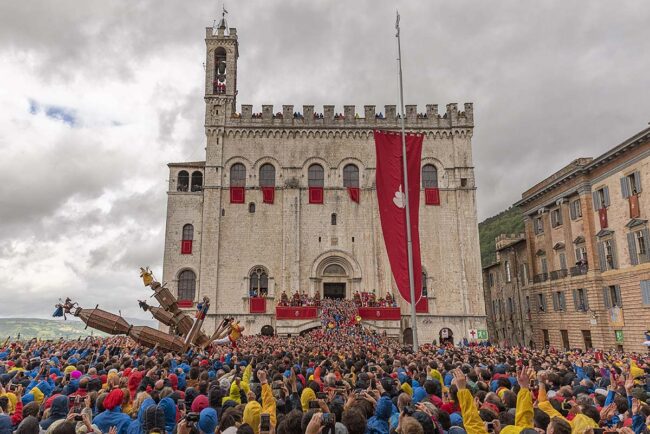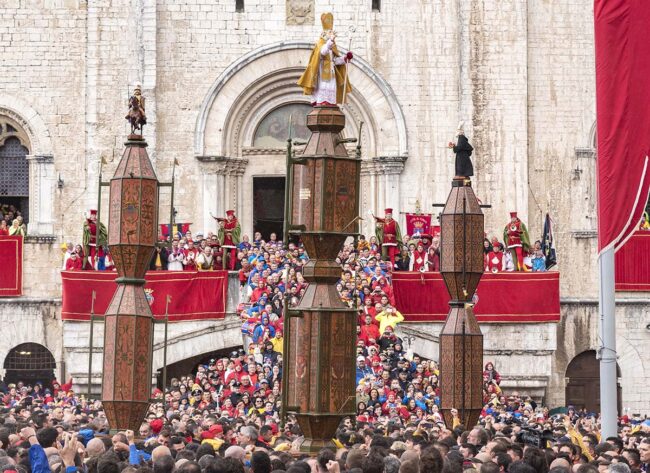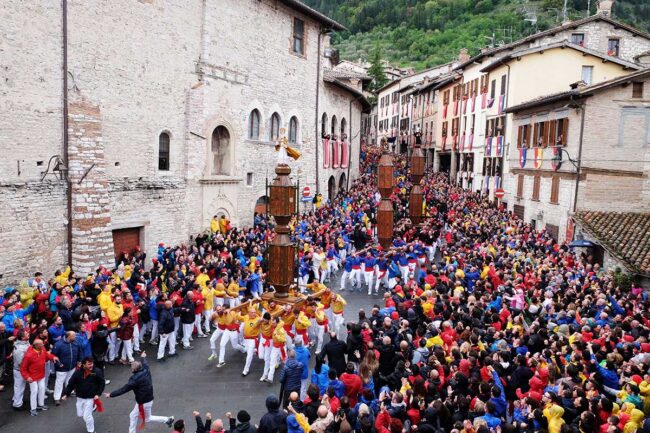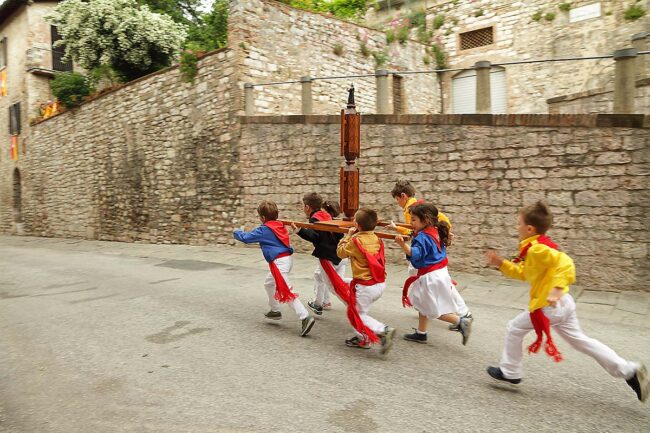The Festa dei Ceri, celebrated annually on May 15th in the town of Gubbio, Umbria, is one of the oldest and most deeply rooted folk traditions in Italy. Its origins can be traced back to the pre-Roman Umbrian rituals, as described in the ancient Iguvine Tablets – bronze inscriptions that testify to the continuity of ceremonial practices over millennia.
At the heart of the celebration is the figure of Saint Ubaldo, the city’s patron saint, whose memory is honored with a breathtaking and symbolic race. During this event, three towering wooden structures – known as the Ceri – each weighing approximately 400 kilograms, are carried on the shoulders of local men through the steep and winding streets of the city up to the Basilica of Saint Ubaldo, located atop Mount Ingino. Each Cero is topped by a statue of a saint, representing ancient societal guilds: Saint Ubaldo stands for the stonemasons, Saint George for the artisans and tradesmen, and Saint Anthony the Abbot for the farmers and rural workers.
The Festa dei Ceri is far more than a historical reenactment. It is a living tradition, felt year-round by the people of Gubbio – known as the Eugubini – who identify deeply with one of the three saints. Being a ceraiolo, a bearer of the Cero, is considered a central element of local identity. The roles, values, and knowledge associated with the festival are not formally taught but are transmitted organically from generation to generation, often within the same family. Participating in the festival is seen as a rite of passage, especially for the younger members of the community, and the deep emotional and symbolic significance it carries makes it an experience that shapes personal and collective memory.
The celebration unfolds according to a precise, centuries-old ritual that includes processions, the “alzata” (the vertical raising of the Ceri in front of the crowd), and culminates in a dramatic race at sunset. But beyond the spectacle, the festival also serves a profound psychosocial function: it strengthens bonds among citizens, reinforces a sense of belonging, and offers a moment of unity and shared emotion that transcends social and generational divides.
Over time, the tradition has expanded to include two additional, child- and youth-focused versions of the event: the Ceri Mezzani, carried by teenagers, and the Ceri Piccoli, a miniaturized version for children. These events not only replicate the spirit and structure of the main celebration but serve as formative experiences to nurture the next generation of ceraioli.
However, this deeply rooted cultural event now faces a significant threat from climate change (CC). In recent years, increasingly frequent extreme weather events – such as intense rainfall, landslides, and geological instability along the mountain route – have raised concerns about the safety and feasibility of the festival. The wooden structures of the Ceri themselves are also vulnerable to environmental degradation, and the occurrence of extreme conditions close to May 15th could force the postponement or cancellation of the event, disrupting the long-standing ritual continuity.
In response to these emerging threats, the European HERACLES Project studied the impact of climate change on both the tangible and intangible cultural heritage of Gubbio. The research encouraged several preventive strategies, including environmental monitoring, careful maintenance of the traditional route, conservative restoration of the Ceri, and awareness campaigns to promote environmental respect as a shared community value.
An unprecedented interruption occurred in 2020 and 2021, when the COVID-19 pandemic forced the cancellation of the festival for the first time during peacetime. This sudden absence had a deep emotional and cultural impact. Nevertheless, the community responded with remarkable resilience. Reduced-format religious processions were held, and social media platforms became virtual gathering spaces, most notably through the project “Io Cero” (“I Was There”), which allowed the community to reflect, mourn, and preserve the spiritual essence of the event despite its physical suspension. These experiences emphasized the festival’s underlying values – solidarity, memory, inclusiveness – and reaffirmed its role as a powerful vehicle for intergenerational transmission and social cohesion.
Today, the Festa dei Ceri is officially recognized as a symbol of regional identity by the Region of Umbria since 1973 and acknowledged by the Italian Ministry of Culture as an intangible cultural expression of high demo-ethno-anthropological value. Its enduring relevance lies in the universal values it transmits: brotherhood, remembrance, respect, resilience. In the current context, it is also seen as a potential platform for environmental awareness, capable of promoting sustainable practices and attitudes while preserving the cultural heritage of a people who have celebrated life, struggle, and faith – together – for centuries.




